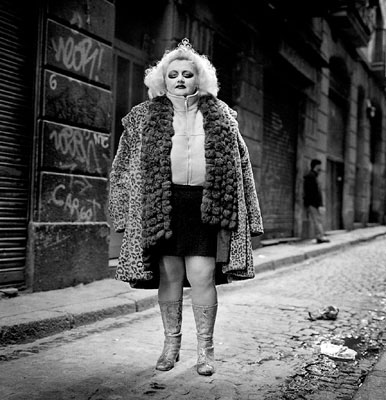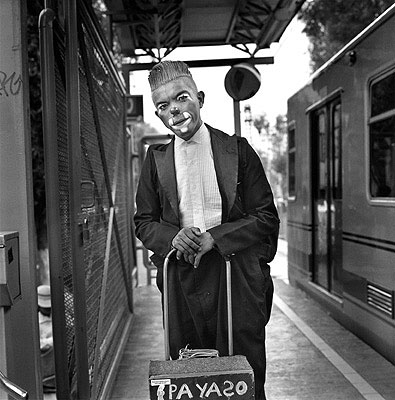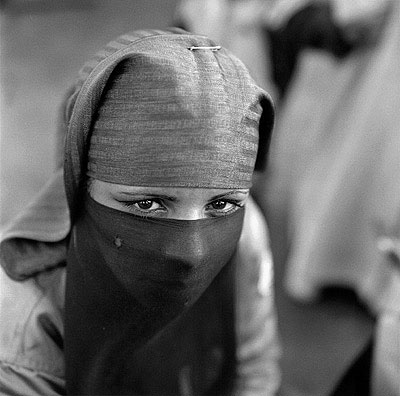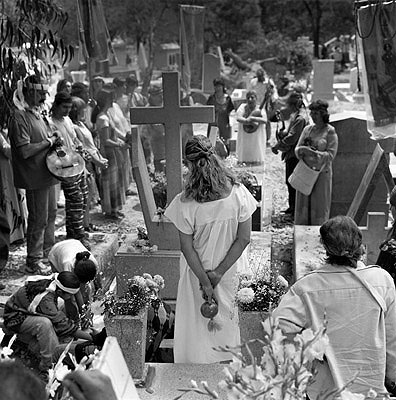
La puta
2005
46x46cm
gelatinobromuro de plata sobre papel baritado
Aitor Lara »
Dragoman
Exhibition: 27 Oct – 25 Nov 2006
Galeria PazYcomedias
C/ Comedias, 7 – 2ª
46003 Valencia
+34 96-3918906
info@pazycomedias.com
www.pazycomedias.com
Tue-Sat 10-14 + 17-21 . Mon 17-21
Aitor Lara (Baracaldo, Vizcaya, 1974) won the first prize in the contest organised by the Juana de Aizpuru gallery in 1999 and began an artistic career that has situated him as one of the up and coming talents of his generation in documental photography. Since then he has participated several editions of ARCO and PARISPHOTO. He has had a solo show in the Juana de Aizpuru gallery in Sevilla (June 2000),and he has work in the photographic collection of the Madrid Regional Government (CAM). In 2004 Lara was awarded the Clavijo grant of the Casa Asia to produce a project on the journeys of Ruy de Clavijo in Samarkanda. Lara publishes his work regularly in the bulletin the Spanish Geographic Society. Currently living in Sevilla, during 2006 his photographs have been published (together with the work of Luis Asín, Atín Aya, Javier Campano and Carlos Pérz Siquer) in the book A Graphic History of the Bullring of Sevilla and he is currently working on a monographic book edited by the Real Maestranza de Caballería de Sevilla, which will be published in 2008. pazYcomedias gallery of Valencia presents Aitor Lara’s first show in the city. The exhibition titled "Dragoman" consists of 25 black and white photographs produced with film cameras and developed with conventional chemical processes. Lara has an immense body of work, fruit of his projects in the streets of Sevilla, Madrid and Barcelona, and of his projects in countries on the peripheries of the western world (Mexico, Uzbekistan, Senegal and Morocco) to carry out his photographic / documental studies and research of the characteristics of each socio-cultural context. Through the lineal development of these specific works Lara has developed a very personal approach to photography which goes beyond the purely documental, and situates his work in the artistic field in the widest sense. Offering a transversal perspective of his work, putting in a second plane each context, allows a focusing on his personal and incisive way of working with the subjects of his portraits and offers non-lineal readings of his work: spatial and temporal leaps that convert the mix of contexts into the universal scene of "human drama". The selection of images from different times and places in the world offers a coherent show of his art that runs a line between an exacerbated realism and an expressionist poem of the human condition, in which the photographer/author disappears, opening up a space between the scene and the viewer. This disappearance of the presence of the author before his subjects is what creates a mysterious relation between the curious, voyeuristic gaze of the spectator, and the deep and naked gaze of the subjects that exhibit, with a rare sincerity, their personal psychological condition that is impregnated with the socio-cultural characteristics of each environment. Aitor Lara has described this subtle process in the following way: "By photographing we open up a channel of communication and we establish new links to reality. It is as much a method of gaining knowledge as a way of being in the world, because the peculiarity of photography is not only found in the image produced but also in the relations created". ________ Español _________ Aitor Lara (Baracaldo, Vizcaya, 1974) ganó el Primer Premio de Fotografía Juana de Aizpuru en 1999, e inició una carrera artística que le ha situado como uno de los grandes talentos de su generación en la fotografía documentalista. Desde entonces ha participado en todas las ediciones de ARCO y de PARISPHOTO, ha tenido una exposición individual en la Galería Juana de Aizpuru de Sevilla (Junio 2000), tiene obra en la Colección Fotográfica CAM, (Comunidad Autónoma de Madrid). En 2005 Lara ganó la beca Clavijo de Casa Asia para un proyecto sobre el viaje de Ruy de Clavijo en Uzbekistan. Lara publica periodicamente sus reportajes en el boletín de la Sociedad Geográfica Española. Actualmente residente en Sevilla, durante 2006 ha tenido sus imágenes publicadas (juntas con Luis Asín, Atín Aya, Javier Campano y Carlos Pérez Siquier) en el libro Historia gráfica de la plaza de toros de Sevilla y está trabajando en un libro monográfico editado por la Real Maestranza de Caballería de Sevilla, que se publicará en 2008. La galería pazYcomedias de Valencia presenta la primera muestra en la ciudad de Aitor Lara. La exposición, cuyo título es "Dragoman", consiste en 25 fotografías en blanco y negro realizadas con cámaras analógicas y reveladas por métodos convencionales. Lara tiene un inmenso cuerpo de trabajo, fruto de sus proyectos en las calles de Sevilla, Madrid y Barcelona, y sus viajes constantes a paises periféricos del mundo occidental (México, Uzbekistan, Senegal, Marruecos) para realizar estudios de cáracter antropológico, en el estilo documentalista, mostrando los rasgo propios de cada contexto histórico-cultural. A través del desarrollo lineal de estos trabajos específicos, Lara ha llegado a un modus operandi muy personal que supera lo documental, y situa su trabajo en el campo artístico en el sentido más amplio. Una perspectiva transversal de su obra, poniendo en segundo plano cada contexto, permite destacar su personal e incisivo modo de trabajar con los sujetos de sus retratos y ofrece lecturas no lineales: saltos espacio-temporales que convierten la mezcla de contextos en el escenario universal del "drama humana". La selección de imágenes, que proceden de diferentes periodos y lugares del mundo, ofrece una muestra coherente de su arte que oscila entre un realismo exacerbado y un poema expresionista sobre la condición humana, en el que el fotógrafo/autor desaparece, abriendo el espacio entre el acontecimiento y quien mira. Ésta desaparición de la presencia del autor delante de los sujetos es lo que crea una misteriosa relación entre la mirada curiosa de voyeur del espectador y la profunda y desnuda mirada de los sujetos que exhiben, con una inusitada sinceridad, su condición psicológica personal impregnada con los rasgos socio-culturales de cada lugar. Aitor Lara ha descrito éste sútil proceso de la siguiente manera "Fotografiando abrimos una vía de comunicación y establecemos nuevos vínculos con la realidad. Es tanto un método de conocimiento como un modo de estar en el mundo, porque la peculiaridad de la fotografía no solo radica en la imagen que produce sino en la relación que crea."

Payaso Xochimilco
2002
46 x 46cm
gelatinobromuro de plata sobre papel baritado

Escorpión
2003
46 x 46cm
gelatinobromuro de plata sobre papel baritado

Irma
Nanita
2002
46 x 46cm
gelatinobromuro de plata sobre papel baritado